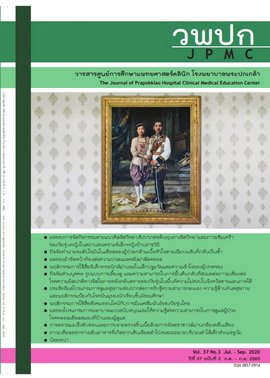Factors Predicting Serum Lipid Level among Patients with Recurrent Acute Myocardial Infarction
Main Article Content
Abstract
Background: Prevention of recurrent acute myocardial infarction achieved by controlling serum lipid levels at optimal levels, the patients’ perceptions of their illnesses and performing good behaviors including food consumption, exercise, adherence to medication, and smoking cessations.
Objective: This predictive correlation research aimed at examining the serum lipid levels among patients with recurrent acute myocardial infarctions and at studying the predictive power of five factors to affect the serum lipid levels among patients with recurrent acute myocardial infarctions.
Method: The subjects consisted of 91 individuals, who were patients with recurrent acute myocardial infarctions and who had received treatment at hospitals in the Eastern Region.
The subjects were selected by using simple random sampling. Data collection was conducted between January 2018 and January 2019. The research instruments consisted of the following: 1) a demographic questionnaire, 2) a medical records form, 3) an illness perceptions questionnaire, 4) an eating behaviors questionnaire, 5) an exercise behaviors questionnaire, 6) a medication adherence questionnaire, and 7) a smoking behavior questionnaire. Descriptive statistics and multiple linear regression analysis were employed to analyze the data.
Results: The mean serum lipid levels of the patients with recurrent acute myocardial infarctions had shown the total cholesterol levels to be normal (M = 173.4, SD = 46.9),
while the LDL cholesterol levels had been higher than the target (M = 109.3, SD = 41.8). Both the HDL cholesterol levels (M = 43.1, SD = 12.0) and the Triglyceride levels (M = 148.4, SD = 60.9) had been normal. The behavioral factor of medication adherence could predict the serum lipid levels of patients with recurrent acute myocardial infarctions in that the total cholesterol and LDL cholesterol had been statistically significant (β = -4.20, p = 0.02 and β = -5.65, p < 0.001). All factors can predict the LDL cholesterol at 10% (Adjust R2= 0.10, p = 0.01).
Conclusion: The mean LDL cholesterol of patients with recurrent acute myocardial infarctions had been higher than the normal values. This study suggests that nurses should be promoting medication adherence, which could determine the LDL cholesterol levels of patients with acute myocardial infarctions and could reduce recurrences.
Article Details
References
Ministry of Public Health, Bureau of Policy and Strategy. Public health statistics A.D. 2015 [Internet]. 2015[cited 2018 Dec 20]; Available from: http://bps.moph.go.th/new_bps/sites/default/files/health_statistic2558.pdf
Jokhadar M, Jacobsen SJ, Reeder GS, Weston SA, Roger VL. Sudden death and recurrent ischemic events after myocardial infarction in the community. Am J Epidemiol 2004;159: 1040–1.
Thanaphatsorn N, Howteerakul N, Sujirarat D, Suwannapong N, Kehasukcharorn W. Incidence and factors associated with instent restenosis in coronary heart disease patients at chest disease institute Nonthaburi Province. RSU National Research Conference; 2015 April 24; Pathumthani: Rangsit University; 2015. P.201-9.
Saisongkorh V, Kunaprasert K, Tangkiatkumjai M. Characteristics of patients with recurrent acute coronary syndrome. Thai Pharmaceutical and Health Science Journal 2010;5:103-6.
Grundy SM, Cleeman JI, Merz CNB, Brewer HB Jr, Clark LT, Hunninghake DB, et al. Implication of recent clinical trials for the National Cholesterol Education Program Adult Treatment Panel III guidelines. Circulation 2004;110:227-39.
The Royal College of Physician of Thailand. 2016 RCPT Clinical practice guideline on pharmacologic therapy of dyslipidemia for atherosclerotic cardiovascular disease prevention. Pathumthani: A-Plusprint; 2016.
Smith SC, Benjamin EJ, Bonow RO, Braun LT, Creager MA, Franklin BA, et al. AHA/ACCF secondary prevention and risk reduction therapy for patients with coronary and other atherosclerotic vascular disease: 2011 update. Circulation 2011;124:2458-73.
Damrongsin S, Putwatana P, Khuwatsamrit K. Self–care behaviors among patients with coronary in-stent restenosis. Journal of The Royal Thai Army Nurses 2017;18(2):220-7.
Cameron LD, Leventhal H, editor. The self-regulation of health and illness behavior. New York: Routledge, 2003.
Foosuwan S, Lirtmunlikaporn S, Singkaew J. Factors predicting serum lipid level among persons with dyslipidemia in community. Nursing Journal 2016;43(2):79-89.
Sole ML, Klein DG, Moseley MJ. Introduction to critical care nursing. 7nd ed. China: Elsevier; 2017.
Stone NJ. Successful control of dyslipidemia in patients with metabolic syndrome: focus on lifestyle changes. Clin Cornerstone 2006;8(Suppl1):s15-s20.
Rungsilp M, Soorapan S, Pongwecharak J, Vongpuwarak P. The effects of pharmaceutical care provision on patients with acute coronary syndromes and hypercholesterolemia at Patthalung Hospital. Songkla Med J 2008;26:261-274.
Falko JM. Balancing efficacy and tolerability issues with statin therapy- considerations for the use of pitavastatin in special patient populations. US Endocrinol 2015;7:30-9
Lekskulchai V.Toxic of cigarette smoke. J Health Res 2007;21:287-92.
Mouhamed DH Ezzaher A, Neffati F, Gaha L, Douki W, Najjar MF. Association between cigarette smoking and dyslipidemia. Immuno-analyse & Biologie Spécialisée 2013;28:195-200
Srisatidnarakul B. The methodology in nursing research. Bangkok: U&I inter media Co., Ltd; 2010.
Thongmak K, Kritpracha C, Srikeaw M. Illness perceptions, receiving information and cardiac rehabilitation behaviors in patients with acute coronary syndrome after discharge. Proceedings of RSU Research Conference; 2011 April 5; Pratumthani: Rangsit University; 2011. P.10-7.
Shang P, Liu GG, Zheng X, Ho PM, Hu S, Li J, et al. Association between medication adherence and 1-year major cardiovascular adverse events after acute myocardial infarction in China. J Am Heart Assoc [Internet]. 2019[cited 2018 Dec 20] ;8(9):e011793. Avaliable from: https://www.ahajournals.org/doi/epub/10.1161/JAHA.118.011793

